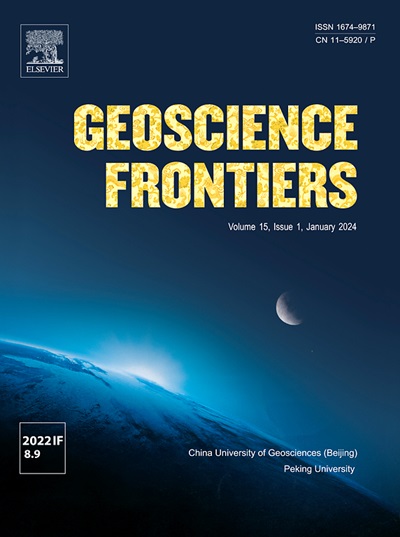富水上地幔中菱铁矿的脱碳
IF 8.5
1区 地球科学
Q1 GEOSCIENCES, MULTIDISCIPLINARY
引用次数: 0
摘要
俯冲板块内的含水流体有可能影响碳酸盐存在的形式和碳循环过程。利用菱铁矿晶体和晶粒与水在压力高达11.4 GPa、温度高达530℃的条件下进行电阻加热金刚石砧孔实验。这些实验旨在模拟可能发生在340公里深的俯冲板块内的地质反应。利用拉曼光谱技术监测样品腔内随压力和温度升高的反应和微尺度现象。用扫描电镜和透射电镜对回收产物进行了分析。结果表明:在0.8 GPa和108℃下,样品表面发生费托反应(FTT),生成有机化合物甲醛,随后观察到甲酸。在更高的压力和温度下(3.5 GPa, 420℃),样品表面形成γ-Fe2O3和γ-FeOOH,并伴有CO2和H2的释放。对淬火产物粉末的透射电镜分析表明,所生成的氧化铁与在高压和高温条件下观察到的相一致。菱铁矿在水中的高压和高温溶解实验表明,碳可能完全以CO2的形式释放到地幔楔体中,在俯冲至75 km深处的热俯冲板和冷俯冲板中。释放的二氧化碳参与了70-120公里深处上地幔岛弧火山系统的碳循环,加速了俯冲碳向地球表面的转移。本文章由计算机程序翻译,如有差异,请以英文原文为准。

Decarbonization of siderite in the water-rich upper mantle
The aqueous fluids within subducted slabs have the potential to influence the form of carbonate presence and the carbon cycling process. Experiments were performed on resistive heating diamond anvil cell using siderite crystals and grains with water under conditions of pressure as high as 11.4 GPa and temperatures reaching up to 530 °C. These experiments aimed to simulate geological reactions that may occur within a depth range of 340 km in subducted slabs. Raman spectroscopy was employed to monitor the reactions and microscale phenomena within the sample chamber as pressure and temperature increase. The recovered products were analyzed using scanning electron microscopy and transmission electron microscopy. The results indicate that at 0.8 GPa and 108 °C, a Fischer-Tropsch Type (FTT) reaction occurred on the sample surface, resulting in the formation of organic compound formaldehyde, followed by the observation of formic acid. At higher pressure and temperature (3.5 GPa, 420 °C), the formation of γ-Fe2O3 and γ-FeOOH was observed on the sample surface, accompanied by the release of CO2 and H2. Transmission electron microscope analysis of the quenched product powders indicated that the generated iron oxides were consistent with the phases observed at high pressure and temperature conditions. High pressure and temperature dissolution experiments of siderite in water reveal that carbon may be released into the mantle wedge entirely in the form of CO2 in warm subducted slabs and cold subducted slabs that subduct to depths of 75 km. The released CO2 participates in the carbon cycle of the island arc volcanic systems in the upper mantle at depths of 70–120 km and accelerates the transfer of subducted carbon to the Earth’s surface.
求助全文
通过发布文献求助,成功后即可免费获取论文全文。
去求助
来源期刊

Geoscience frontiers
Earth and Planetary Sciences-General Earth and Planetary Sciences
CiteScore
17.80
自引率
3.40%
发文量
147
审稿时长
35 days
期刊介绍:
Geoscience Frontiers (GSF) is the Journal of China University of Geosciences (Beijing) and Peking University. It publishes peer-reviewed research articles and reviews in interdisciplinary fields of Earth and Planetary Sciences. GSF covers various research areas including petrology and geochemistry, lithospheric architecture and mantle dynamics, global tectonics, economic geology and fuel exploration, geophysics, stratigraphy and paleontology, environmental and engineering geology, astrogeology, and the nexus of resources-energy-emissions-climate under Sustainable Development Goals. The journal aims to bridge innovative, provocative, and challenging concepts and models in these fields, providing insights on correlations and evolution.
 求助内容:
求助内容: 应助结果提醒方式:
应助结果提醒方式:


